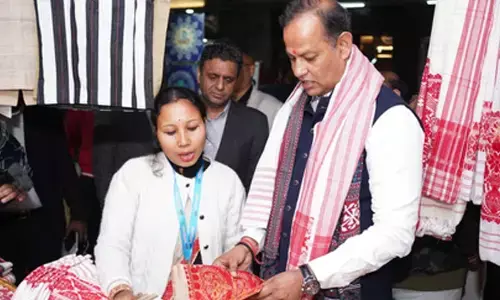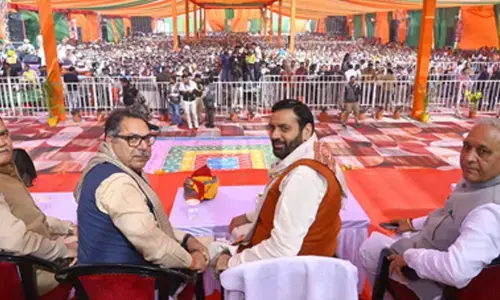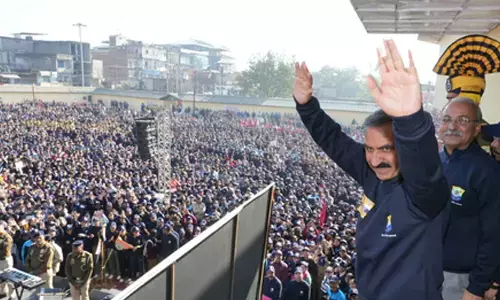India Lands on the Moon!
Share :

India’s moon lander successfully set its four legs softly and safely on the lunar soil on Wednesday evening as planned, and became the fourth nation in the world to achieve the feat.
Chennai: India’s moon lander successfully set its four legs softly and safely on the lunar soil on Wednesday evening as planned, and became the fourth nation in the world to achieve the feat.
The lander landed near the South Pole of the moon after travelling about 3.84 lakh km for over 40 days.
With the landing, a major portion of the Rs 600 crore Chandrayaan-3 mission has been realised. The remaining portion is the moon rover rolling down from the lander, moving around and doing the programmed experiments.
The Chandrayaan-3 spacecraft comprises a propulsion module (weighing 2,148 kg), a lander (1,723.89 kg) and a rover (26 kg).
According to the Indian Space Research Organisation (ISRO), the moon rover has Alpha Particle X-ray Spectrometer (APXS) and Laser Induced Breakdown Spectroscope (LIBS) for deriving the elemental composition in the vicinity of the landing site.
On its part, the lander too will carry out the tasks assigned to it with its payloads: Chandra’s Surface Thermophysical Experiment (ChaSTE) to measure the thermal conductivity and temperature; Instrument for Lunar Seismic Activity (ILSA) for measuring the seismicity around the landing site; Langmuir Probe (LP) to estimate the plasma density and its variations. A passive Laser Retroreflector Array from NASA is accommodated for lunar laser ranging studies.
The mission life of the lander and the rover is 1 Lunar day or 14 Earth days, ISRO said
The propulsion module has Spectro-polarimetry of Habitable Planet Earth (SHAPE) payload to study the spectral and Polari metric measurements of Earth from the lunar orbit.
The life of the payload carried by the propulsion module post ejection of the lander is between three and six months.
The 19 minutes of suspense and excitement began at 5.45 p.m., as planned earlier, and ended at 6.05 p.m. with the lander touching down on the lunar soil.
It may be recalled that the Vikram lander that was part of the Chandrayaan-2 mission a couple of years back had crashed on the moon while it was on the last phase of landing.
The soft landing is a tricky issue as it involves a series of complex manoeuvres consisting of rough and fine braking.
Imaging of the landing site region prior to landing will be done for finding safe and hazard-free zones.
The powered descent of the lander in a horizontal position began from an altitude of about 30 km at about 5.45 p.m. The automatic landing sequence got activated.
During the rough breaking phase the lander’s speed will be brought down from 1,680 metres per second to 358 metres per second. The altitude will be brought down 7.4 km above the moon.
The next phase was the altitude hold phase where the altitude was brought down to 6.8 km.
The officials seated at the Mission Operations Complex at ISRO Telemetry, Tracking and Command Network (ISTRAC), Bengaluru, had their eyes glued to their monitors.
The lander’s position changed to vertical and the craft hovered 150 metres over the moon, taking pictures and surveying the landing zone to decide on a safe landing spot.
Then the safe landing happened with two engines on out of the four.
The primary communication channel will be the Mission Operations Complex at ISTRAC, Bengaluru, to Chandrayaan-3 Propulsion Module which in turn would talk to the lander and the rover.
Recently, the moon lander established communication links with the Chandrayaan-2 mission’s Orbiter that is circling the moon since 2019 and thereby having a backup talking channel.
Meanwhile, the propulsion module of Chandrayaan-3 is continuing to go around the moon for some more period with its payload Spectro-polarimetry of Habitable Planetary Earth (SHAPE) doing its job.
The Chandrayaan-3 was put into orbit on July 14 in a copybook style by India's heavy lift rocket LVM3.
The spacecraft completed orbiting around the Earth and headed towards the moon on August 1.















